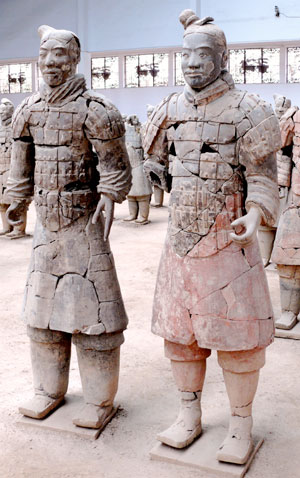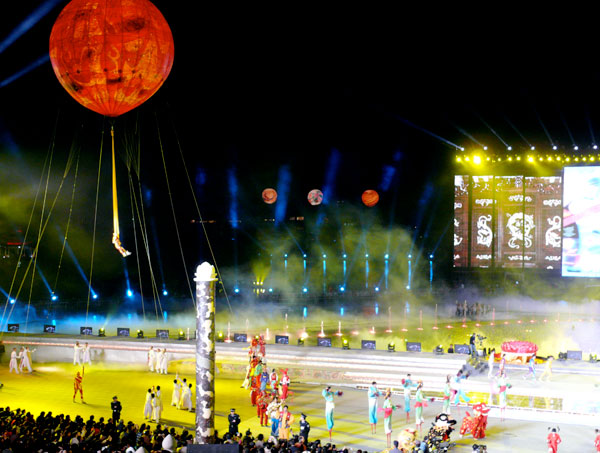XIAN, CHINA – They call this ancient capital the “Jewel of China.” They call this ancient capital the “Jewel of China.” Maybe it's because It sparkles at night.
In fact, Xian is a city bathed in light.
As you fly into this 2,000-year-old city where every major Chinese dynasty from the 2nd century B.C. to the 14th century A.D. called home, the night sky is lit up by a cavalcade of coloured lights.
It’s old city wall — built during the great dynasties and the only one in the country still completely intact — and the large guard towers that line it are outlined in tiny coloured lights.
The gates leading into the old city are spotlighted by coloured lights, as are most of the historic buildings and temples. The modern streets outside the old city are decorated with large neon signs that are so bright they turn night into day. But the most fascinating light spectacle in Xian is at a place that celebrates the Tang Dynasty, one of the most enlightening periods in Chinese history.
"You see that large cluster of lights down there,” points out our Chinese guide Zhong Yu (Jade) as our plane begins its decent into Xian’s modern airport. “That is where we will be going tonight.
“It’s called the Tang Paradise and it’s our newest attraction,” says the native of Xian, one of China’s five ancient capitals and home to the world famous Terra Cotta Warriors, the greatest archaeological discovery of the 20th century. A few minutes after our plane lands, Jade rushes us into a waiting motorcoach and we head toward the Tang Paradise, the largest cultural theme park in China, where a spectacular laser show lights up the skies each night.
"On our way, Jade tells us that over 70 emperors made Xian, known in ancient times as Chang’an, their headquarters. The city actually served as a capital for more than 1,100 years.
“Of all the emperiors who lived here, the Tang emperor (Tang Gaozong, who ruled from 650-683 AD) was the most dynamic and revered,” beams Jade.
“It was during his reign that China enjoyed its golden age of poetry, song and art,” she tells us. “It was also Emperor Tang who traded with Europe and he started the Silk Road from Xian.
“Many Chinese still refer to themselves as the `Tang People’ in honour of that period of our history,” says the charming guide as the coach turns into the Tang Paradise parking lot.
Jade pushes us in the direction of the brightly lit entrance and tells us to hurry because “the show is about to start.”
The Tang Paradise was built in the shadow of the former Tang emperor’s garden and features a number of large traditional Chinese structures, gardens and squares, all of which are decorated with thousands of lights.
The nightly laser light show began in 2005 and has quickly become one of the biggest tourist attractions in this city that is a treasure chest of Chinese history and culture.
We hurry past hundreds of performers waiting in the wings – all decked out in brightly coloured traditional garb that reflects the entertainers from the Tang period.
“We are very lucky tonight,” Jade tells us. “A high-ranking government delegation is in attendance and they have invited a number of foreign dignitaries to watch the show. That means the show will be even more spectacular tonight.”
Every seat in the amphitheatre is filled and just a few minutes after arriving, the lights dim and the show begins – and wow, what a show!
We are entertained with dances and songs and some of the most spectacular special effects imaginable - made possible by a Chinese invention called a “water film” where visuals are shown on a screen of water that cascades from on high and creates visual effects that produce the most amazing 3-D effects.


Above: The real Terracotta Warriors are located not far from the nightly light show.
“What you are seeing here tonight is what people will see at the opening of the (2008) Olympic Games in Beijing,” Jade tells the group, whose eyes are fixated on the visual spectacle being played out before us.
We are high enough in the amphitheatre to get a panoramic view of the huge park, where pagoda-type buildings are bedecked in brilliant light and shimmer in the surrounding man-made lake.
The two hour show excites us about what else we’ll see in Xian, one of China’s most diverse cities and home to over 500,000 Chinese Muslims, descendents of those converted during the Silk Road period.
Regal Xi’an is home to some of China’s most important historic relics – the Terra Cotta Warriors being on the top of that list – but, according to Jade, has only been recently discovered by foreign tourists.
“No one came to Xian before the Terra Cotta Warriors were discovered (in 1974),” says Jade as we leave the Tang Paradise for our ultra-modern hotel in the middle of Xian and get our first glimpse of the city wall and its impressive guard towers, all made even more awesome by the lights that outline them.
“Our oldest hotel dates back to the late 1980s. Even the Chinese did not come here before the Terra Cotta Warriors were discovered. Now we have many hotels (and many more are being built) and lots of tourists,” says a proud Jade who is excited whenever she gets the chance to show off her birthplace to strangers.
And there’s lot to see in Xian, starting with the Terra Cotta Warriors exhibit, a one-hour drive form the centre of town. It’s a journey back in time – to 2,000 years ago when Emperor Qin Shihuang, at the age of 13, began planning his trip into the after life by building a tomb complete with life-size soldiers, carriages, and lots of his live concubines.
Two years after his death at the age of 50, Qin’s tomb was sealed and not opened again until a local farmer stumbled upon it in the 1970s and unearthed one of the greatest tourist attractions in China.
Now millions come each year to see the warriors and while here uncover some of the other historical wonders Xian offers, like:
- 1,000 or so hill tombs – many belonging to former emperors and their families - that are scattered about the flat farmland surrounding Xian;
- The Wild Goose Pagoda – a Buddhist temple designed after a similar one in India and brought here in 648 A.D. by a monk. There’s also a Small Wild Goose Pagoda that was built in 670 A.D. and equally as impressive as its larger cousin;
- Handsome city streets – all lined with lovely plane trees, the kind you see in Paris, that shade the occupants of Xian from the city’s oppressive summer heat;
- The City Wall – so wide you can ride a bike on it. The massive structure stretches for over 11 kilometres and was built during the Tang Dynasty. The wall features four gates, four impressive guard towers, dozens of ramparts, and a moat. A marathon is held every year on it and Jade tells us it’s “eight horses wide. That’s how they measured things back then.” At the height of the Tang Dynasty, more than 1 million people lived within the wall;
- The Great Mosque – Located in the vibrant Muslim area of the city, the mosque was built 1,300 years ago by a forward-thinking emperor as a show of goodwill to the city’s Muslim population. It’s located in the heart of the bustling Muslim market and offers a tranquil escape from the hawkers;
- The Bell and Drum Towers – They sit within a stone’s throw of each other and were built in the 14th century – one (the Bell Tower) telling the workers of the city when to wake up and the other (the Drum Tower) telling them when it was time to return home;
- The Shaanxi Museum – The provincial museum (Shaanxi is the province where Xian is located) offers 11,000 artefacts from every period of Chinese history, including the three most important dynasties, the Qin, Han and Tang. The museum also showcases human skulls that date back one million years;
- Emperors’ Tombs – There were 13 important dynasties that set up home in Xian, and the remains of their emperors lie beneath the mighty mounds on the outskirts of the city. Most remain untouched – there’s just too many to excavate. The ones that are open include the Qin (home to the warriors), the Han, where Emperor Liu Che resides, the Huo Qubing Tomb; Emperor Li Shimin’s tomb and the Tang emperor’s tomb located on the outskirts of the city. Each of the main tombs is located in idyllic settings. Only the Terra Cotta Warriors are life size, but the miniature soldiers that accompanied other emperors into the after life are just as impressive.
Xian is also home to the best hot springs in China – the emperors and their courts obviously liked the pleasures of life – and have a number of nightly shows that give visitors an insight to what life was like back then.
Xian is a place everyone should see at least once in their lives – especially at night when the city is bathed in light.
“I believe Paris is called the City of Light,” says Jade. “Well, we like to think Xian is the City of Lights.”